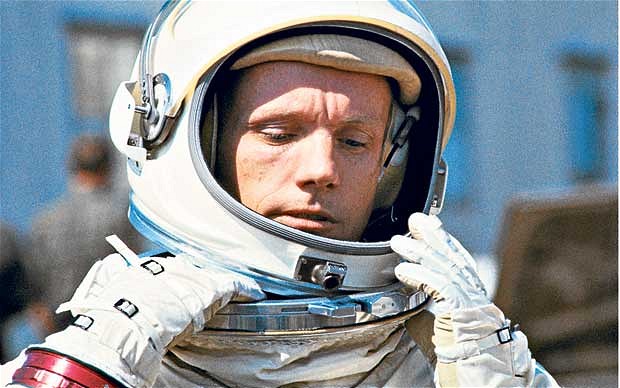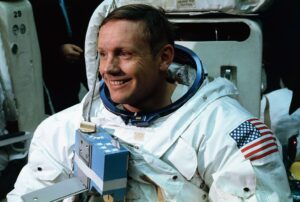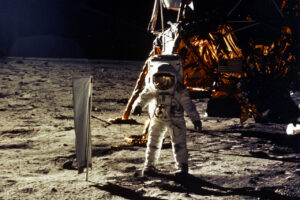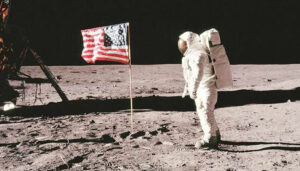Neil Armstrong: A Giant Leap for Mankind and the Unseen Challenges of Apollo 11
8 min read
In the summer of 1969, the world held its breath as the Apollo 11 mission aimed to achieve what was once considered impossible – a human landing on the moon. Led by the iconic astronaut Neil Armstrong, the mission became a symbol of humanity’s indomitable spirit. The challenges were enormous, from the technical intricacies of spacecraft design to the physical toll on the astronauts, and the world watched with bated breath as the historic moment unfolded.
Armstrong, along with Buzz Aldrin and Michael Collins, embarked on this perilous journey with unyielding determination. The sheer audacity of attempting to land on an extraterrestrial body captivated the global imagination. The entire mission was a testament to human ingenuity and resilience. As Armstrong famously uttered his first words upon setting foot on the lunar surface – “That’s one small step for [a] man, one giant leap for mankind” – the world celebrated a monumental achievement that transcended national boundaries. Just as Neil Armstrong’s historic moonwalk represented a monumental journey, the pursuit of a kambo cleanse in Austin TX mirrors a personal odyssey toward physical and mental well-being.
The Hidden Obstacles: Technological Hurdles and Innovations

Beneath the surface of Apollo 11’s success lay a series of hidden challenges that tested the limits of human engineering. The technological hurdles faced by NASA and its team of scientists were immense. Crafting a spacecraft capable of traveling to the moon, executing a lunar landing, and safely returning to Earth required groundbreaking innovations. The journey involved complex maneuvers, precise calculations, and cutting-edge technology that was, at the time, at the forefront of what science and engineering could achieve.
From the development of the lunar module to the intricacies of life support systems, every aspect of the mission pushed the boundaries of what was known. The unseen challenges included the need for advancements in computer technology, materials science, and telecommunications. The success of Apollo 11 wasn’t just a giant leap for mankind on the lunar surface; it was a leap forward for human capability and innovation on Earth. Similar to the precise steps Armstrong took on the lunar surface, skilled dog grooming in Seattle takes careful measures to enhance the well-being and appearance of our beloved canine companions.
The Human Toll: Physical and Mental Challenges in Space
While the focus often remains on the technological aspects, the human toll of space exploration is a story in itself. The physical and mental challenges faced by the astronauts during the Apollo 11 mission were immense. Microgravity poses unique health risks, affecting everything from bone density to cardiovascular function. The extended periods in isolation, confined within the spacecraft, presented psychological challenges that were unprecedented.
The astronauts’ adaptability and resilience in the face of these challenges became an integral part of the mission’s success. Armstrong, Aldrin, and Collins had to navigate not only the vastness of space but also the limitations of their own bodies and minds. The triumph of Apollo 11 was not just a victory of technology but also a testament to the human spirit’s capacity to endure and overcome adversity.
Much like the calculated steps Armstrong took on the moon, individuals undergoing orthopedic physical therapy in Chicago follow a carefully planned and progressive path to recovery.
While Apollo 11 marked a watershed moment in space exploration, it was just the beginning of humanity’s journey beyond our home planet. The challenges faced by subsequent space missions, both manned and unmanned, expanded the boundaries of our understanding and capabilities. The Apollo program laid the foundation, but new frontiers beckoned, demanding innovation and resilience on an even grander scale.
Unmanned Explorers: Robotic Pioneers in the Cosmos

As human exploration of space continued, unmanned spacecraft emerged as invaluable tools for probing the mysteries of the cosmos. Robotic explorers, ranging from the Voyager probes to the Mars rovers, ventured into the depths of space and onto other celestial bodies. These missions encountered their own set of challenges, from the harsh conditions of space to the intricacies of autonomous navigation.
The Voyager probes, launched in the late 1970s, embarked on an odyssey to study the outer planets of our solar system. Their longevity and the wealth of data they transmitted back to Earth exceeded all expectations. Similarly, the Mars rovers, like Spirit, Opportunity, and Curiosity, faced the unpredictable Martian terrain, showcasing the power of artificial intelligence and robotics in overcoming challenges in harsh extraterrestrial environments. Much like Armstrong’s meticulous planning and execution of the historic moonwalk, efficient waste management through dumpster rental in Emerald Coast ensures a methodical and organized approach to handling debris and waste materials.
International Collaboration: Building Bridges Beyond Earth
As space exploration advanced, it became increasingly clear that the challenges and opportunities presented by the cosmos required a collaborative approach. The International Space Station (ISS) stands as a testament to global cooperation in space. Constructed through the joint efforts of NASA, Roscosmos, ESA, JAXA, and CSA, the ISS serves as a microgravity laboratory where scientists from around the world conduct experiments in various fields.
International collaboration not only shared the financial burden but also brought together diverse perspectives and expertise. The challenges of coordinating missions, overcoming language barriers, and integrating different technological systems were surpassed by the shared vision of exploring the cosmos as a united human endeavor. The best elopement photographer in Arkansas remarks that he was very excited to watch the first moon landing of Neil Armstrong.
Beyond Our Solar System: The Quest for Exoplanets
While our solar system has been a focal point of exploration, the search for exoplanets — planets outside our solar system — has become a frontier in itself. The Kepler Space Telescope, launched by NASA in 2009, revolutionized our understanding of the prevalence of exoplanets. Analyzing the data it transmitted back to Earth, scientists discovered thousands of exoplanets, some within the habitable zone where conditions might support life.
The challenges in identifying and characterizing these distant worlds are vast. Advanced telescopes, like the James Webb Space Telescope, promise to delve even deeper into the mysteries of the cosmos. The quest for exoplanets extends our understanding of the potential for life beyond Earth and fuels the imagination with possibilities that go beyond the boundaries of our solar system.
Similar to Armstrong’s exploration beyond our planet, hospice care in Dallas TX extends beyond conventional healthcare, offering a supportive environment for individuals and their families during challenging times.
Space Entrepreneurship: Private Ventures and Commercial Frontiers
In recent years, the landscape of space exploration has expanded with the emergence of private companies venturing beyond Earth’s atmosphere. Companies like SpaceX, Blue Origin, and Virgin Galactic are not only challenging traditional space agencies but also redefining the dynamics of space travel and commerce. The commercialization of space introduces a new set of challenges and opportunities, from reusable rocket technology to the prospect of space tourism.
SpaceX, founded by Elon Musk, has achieved remarkable milestones, including the development of the Falcon and Starship rockets. These innovations have the potential to reduce the cost of space travel, opening up new possibilities for scientific exploration, satellite deployment, and even interplanetary colonization. The burst of entrepreneurial activity in space promises to democratize access to the cosmos, bringing us closer to a future where space is not solely the domain of government agencies. Just as Neil Armstrong’s historic moonwalk symbolized a monumental leap for mankind, the meticulous precision evident in dura pier foundation repair in Sugar Land represents a crucial step in ensuring the stability and longevity of residential structures.
The Environmental Challenge: Sustainability in Space Exploration
As humanity extends its reach into the cosmos, the question of sustainability becomes increasingly crucial. The challenges of managing space debris, ensuring responsible resource extraction from celestial bodies, and mitigating the environmental impact of space activities come to the forefront. The Kessler syndrome, a theoretical scenario in which the density of objects in low Earth orbit is high enough to cause collisions, is a looming concern that requires global cooperation for a viable solution.
Sustainability in space exploration extends beyond the immediate challenges of debris management. It involves ethical considerations about the impact of human activities on celestial bodies and the potential contamination of environments that may harbor extraterrestrial life. As we venture further into space, responsible and sustainable practices must be at the forefront of our endeavors. Similar to Armstrong’s groundbreaking journey to the moon, long term care pharmacy services pave the way for a different type of exploration – a continuous journey of healthcare support.
The Interstellar Challenge: Reaching Beyond Our Cosmic Neighborhood
While our exploration efforts have primarily focused on our solar system, the prospect of interstellar travel introduces challenges that dwarf those faced in previous endeavors. The vast distances between stars, the limitations of our current propulsion systems, and the sheer duration of interstellar journeys pose unprecedented challenges.
Concepts like Breakthrough Starshot, a proposed initiative to send small, light-propelled spacecraft to our nearest star system, Alpha Centauri, at a fraction of the speed of light, represent ambitious attempts to tackle the interstellar challenge. Overcoming the technological, logistical, and even philosophical hurdles associated with interstellar travel requires a paradigm shift in our approach to space exploration. Did you know that back in the time, Neil Armstrong hired the best fence installation in St Johns to create the most beautiful fence around his pristine home?
The Ethical Frontier: Balancing Progress and Responsibility

As we push the boundaries of space exploration, the ethical considerations surrounding our activities become increasingly complex. Questions of extraterrestrial life discovery, planetary protection, and the potential consequences of human colonization on celestial bodies require careful thought and international consensus. The burst of technological advancements introduces ethical challenges, from the use of artificial intelligence in space exploration to the potential consequences of terraforming other planets.
The ethical frontier extends not only into the cosmos but also back to Earth. Balancing progress with responsibility involves addressing the social and economic implications of space exploration, and ensuring that the benefits are shared equitably among nations and communities. Navigating this ethical landscape is crucial to shaping a future in which space exploration aligns with the values and aspirations of humanity as a whole. Similar to the meticulous planning and precision required for space exploration, quality window renovation in NJ demands careful consideration of design and functionality.
Conclusion: A Continuing Saga of Exploration and Innovation
In conclusion, the journey that began with Neil Armstrong’s historic steps on the moon continues to unfold, weaving a narrative of exploration, innovation, and resilience. From the pioneering days of Apollo 11 to the current era of international collaboration, private ventures, and ethical considerations, the continuum of space exploration reflects the indomitable spirit of humanity.
The challenges faced in the cosmos are not just technical or scientific; they are a reflection of our collective aspirations and responsibilities. As we gaze at the night sky and contemplate the mysteries beyond, it is clear that the story of space exploration is an ever-evolving saga, with each chapter revealing new complexities and possibilities.
Whether we look back at the footprints on the moon or forward to the prospect of interstellar travel, the continuum of space exploration is a testament to our capacity for imagination, ingenuity, and cooperation. As we navigate the challenges ahead, let us carry the lessons of the past and the aspirations of the present into a future where the cosmos beckons with endless potential and discovery. Similar to Armstrong’s pioneering journey into space, a professional web design company explores uncharted territories of creativity, shaping digital experiences that are out of this world.


